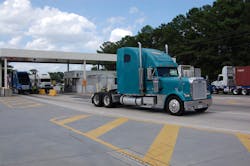To say that there’s a lot of disruption occurring in the trucking industry right now – with more ahead on the horizon – is like saying Godzilla is a slightly-larger-than-average lizard.
Disruption in trucking’s case is poised to act like a tidal wave that could potentially sweep away many of its “traditional” elements and replace them with new ones.
Many of those “replacements” are the stuff of science fiction movies, too, such as driverless trucks, drones, the Internet of Things (IoT), and Big Data.
[Go here and here for more analysis of this “disruptive” trend line.]
Many believe all of this “disruption” will harm more than help trucking companies, but is that necessarily so? Rather, could motor carriers actually harness those “disruptive elements” to better defend their business lines long term?
The jury is probably going to be out for a while regarding the potential success of such a strategy, but if a new survey conducted by Grant Thornton LLP with over 1,000 U.S. business executives is any guide, there is a chance such a philosophy might work well for trucking.
According to that survey, part of Grant Thornton’s Future of Growth and Industry report, so-called “leader” companies – those with sustained earnings and revenue growth – make “bold decisions” to reinvent themselves, whereas by comparison, “follower” companies – those with flat earnings and revenues – are not prioritizing the same activities to position themselves to compete in the future.Based on Grant Thornton’s poll, nearly four-fifths (79%) of “leader” companies prioritize developing products or services that allow them to move into a new sector. By comparison, only roughly one-third (35%) of “follower” companies do the same.
A similar dichotomy can be seen when it comes to risk – with more than two-thirds (69%) of “leader” companies placing a high priority on balancing risk and opportunity, whereas well under half (42%) of “follower” companies take the same approach.
“Understanding the upside value of risk – and recognizing when risk-taking is appropriate – is a challenge for many organizations, as they grapple with ever-changing customer needs and the emergence of new competitors and technologies,” noted Nichole Jordan, Grant Thornton’s national managing partner of markets, clients and industry.
“But our study indicates that growing companies see disruption as something to be exploited – and they are supported by risk leaders who expand their department’s role beyond compliance,” she stressed.
Here are a few other findings from the firm’s report worth pondering:
- Expansion into new geographic markets is another area where “leaders” and “followers” diverge: 66% and 23%, respectively, consider it a high priority.
- Nearly three-quarters (73%) of “leader” companies plan to use automation to improve process efficiency, compared with just 48% of “follower” companies.
Indeed, Wells Fargo & Company found in its poll of 208 business leaders that 41% of U.S. companies say Canada will be important to their future business success. Canada, which had fallen out of the top three in 2016, is now tied with China at No. 1, followed by Mexico with 32%.
The firm’s most recent indicator also registered a score of 74, marking the highest result since its inception in 2014 and a nine-point increase since last year.
Much of this sentiment revolves around international trade – a “pivotal issue” in terms of freight volume for truckers – and right now, despite high optimism for business prospect, there’s a lot of concern about potential changes to existing trade pacts.
Some 86% of respondents to Wells Fargo’s poll said that the failure of trade pacts would impact their business “somewhat” or “a great deal,” with 78% of U.S. business leaders “somewhat” or “very concerned” about the growing negative attitudes towards trade agreements.
Additionally, when asked about the importance of specific trade pacts to their international business, the Trans-Pacific Partnership was listed as the most important (80%), followed by the North American Free Trade Agreement (74%), the Transatlantic Trade and Investment Partnership (73%), and the Dominican Republic-Central American Free Trade Agreement (56%).
And if trade worries aren’t “disruptive” enough, consider these rising risk factors cited by those responding to Wells Fargo’s survey:
- The majority of U.S. companies (91%) listed cyberattacks as their top concern.
- Political stability outside of the U.S. was also a top concern at 83%, up from 58% in 2016.
- Potential interest rate increases by the Federal Reserve rounded out the top three, making a huge jump to 80% from 42% in 2016.
John Larkin – managing director and head of transportation capital markets research for Stifel Capital Markets – added more trucking-specific concerns to that list after spending some time at the annual meeting of the National Strategic Shippers Transportation Council (NASSTRAC) last week:
- The breadth and depth of technology adoption and innovation needed to remain competitive and relevant to one’s customers is daunting;
- It’s also necessary to avoid the “bleeding edge” of technological development, yet not fall too far behind the proven solutions;
- Staying abreast of the seemingly ever changing federal regulatory landscape, particularly given that key Presidential administration appointments to various regulatory agencies relevant to trucking haven’t taken place yet;
- The formulation of a strategy to compete with and/or to develop an alliance with Amazon and/or Uber;
- Determining whether or not the new wave of global nationalism will significantly impact global trade volumes and patterns;
- Keeping an eye on certain states – especially California – that “seem to be inclined” in Larkin’s words to issue regulations that significantly impact interstate commerce, which is interference with one of the relatively few responsibilities constitutionally carved out for the federal government to regulate.
It sure makes for a very full plate of disruption for trucking to deal with. Will it overcome the industry? Or will motor carriers find ways to successfully navigate through it all? We’ll see.


